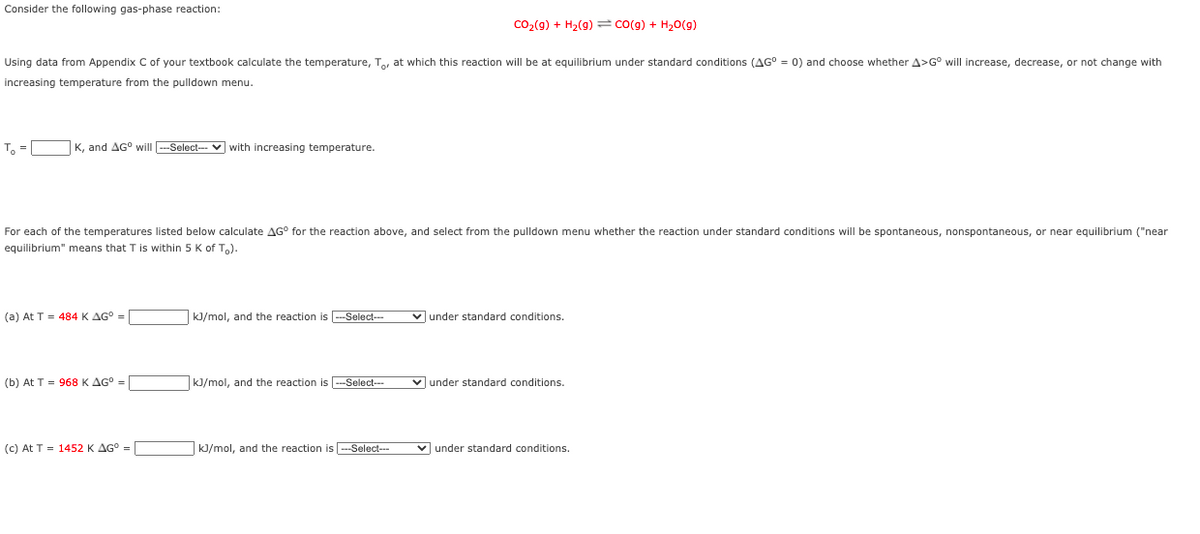Consider the following gas-phase reaction: co,(9) + H2(g)= co(g) + H,0(g) Using data from Appendix C of your textbook calculate the temperature, To, at which this reaction will be at equilibrium under standard conditions (AG° = 0) and choose whether A>G° will increase, decrease, or not change with increasing temperature from the pulldown menu. T. = K, and AG° will ---Select- V with increasing temperature. For each of the temperatures listed below calculate AG° for the reaction above, and select from the pulldown menu whether the reaction under standard conditions will be spontaneous, nonspontaneous, or near equilibrium ("near equilibrium" means that Tis within 5 K of T,). (a) At T= 484 K AG° = kJ/mol, and the reaction is ---Select--- v under standard conditions. (b) At T = 968 K AG° = kJ/mol, and the reaction is --Select-- under standard conditions. (c) At T = 1452 K AG° = kJ/mol, and the reaction is --Select-- v under standard conditions.
Consider the following gas-phase reaction: co,(9) + H2(g)= co(g) + H,0(g) Using data from Appendix C of your textbook calculate the temperature, To, at which this reaction will be at equilibrium under standard conditions (AG° = 0) and choose whether A>G° will increase, decrease, or not change with increasing temperature from the pulldown menu. T. = K, and AG° will ---Select- V with increasing temperature. For each of the temperatures listed below calculate AG° for the reaction above, and select from the pulldown menu whether the reaction under standard conditions will be spontaneous, nonspontaneous, or near equilibrium ("near equilibrium" means that Tis within 5 K of T,). (a) At T= 484 K AG° = kJ/mol, and the reaction is ---Select--- v under standard conditions. (b) At T = 968 K AG° = kJ/mol, and the reaction is --Select-- under standard conditions. (c) At T = 1452 K AG° = kJ/mol, and the reaction is --Select-- v under standard conditions.
Chemistry
10th Edition
ISBN:9781305957404
Author:Steven S. Zumdahl, Susan A. Zumdahl, Donald J. DeCoste
Publisher:Steven S. Zumdahl, Susan A. Zumdahl, Donald J. DeCoste
Chapter1: Chemical Foundations
Section: Chapter Questions
Problem 1RQ: Define and explain the differences between the following terms. a. law and theory b. theory and...
Related questions
Question
100%

Transcribed Image Text:Consider the following gas-phase reaction:
Co2(9) + H2(g) = co(g) + H20(9)
Using data from Appendix C of your textbook calculate the temperature, To, at which this reaction will be at equilibrium under standard conditions (AG° = 0) and choose whether A>G° will increase, decrease, or not change with
increasing temperature from the pulldown menu.
T. =
K, and AG° will ---Select-- v with increasing temperature.
For each of the temperatures listed below calculate AG° for the reaction above, and select from the pulldown menu whether the reaction under standard conditions will be spontaneous, nonspontaneous, or near equilibrium ("near
equilibrium" means that T is within 5 K of T).
(a) At T = 484 K AG° =
kJ/mol, and the reaction is -Select--
v under standard conditions.
(b) At T = 968 K AG° =
kJ/mol, and the reaction is -Select--
v under standard conditions.
(c) At T = 1452 K AG° =
kJ/mol, and the reaction is --Select--
v under standard conditions.
Expert Solution
This question has been solved!
Explore an expertly crafted, step-by-step solution for a thorough understanding of key concepts.
This is a popular solution!
Trending now
This is a popular solution!
Step by step
Solved in 3 steps with 3 images

Knowledge Booster
Learn more about
Need a deep-dive on the concept behind this application? Look no further. Learn more about this topic, chemistry and related others by exploring similar questions and additional content below.Recommended textbooks for you

Chemistry
Chemistry
ISBN:
9781305957404
Author:
Steven S. Zumdahl, Susan A. Zumdahl, Donald J. DeCoste
Publisher:
Cengage Learning

Chemistry
Chemistry
ISBN:
9781259911156
Author:
Raymond Chang Dr., Jason Overby Professor
Publisher:
McGraw-Hill Education

Principles of Instrumental Analysis
Chemistry
ISBN:
9781305577213
Author:
Douglas A. Skoog, F. James Holler, Stanley R. Crouch
Publisher:
Cengage Learning

Chemistry
Chemistry
ISBN:
9781305957404
Author:
Steven S. Zumdahl, Susan A. Zumdahl, Donald J. DeCoste
Publisher:
Cengage Learning

Chemistry
Chemistry
ISBN:
9781259911156
Author:
Raymond Chang Dr., Jason Overby Professor
Publisher:
McGraw-Hill Education

Principles of Instrumental Analysis
Chemistry
ISBN:
9781305577213
Author:
Douglas A. Skoog, F. James Holler, Stanley R. Crouch
Publisher:
Cengage Learning

Organic Chemistry
Chemistry
ISBN:
9780078021558
Author:
Janice Gorzynski Smith Dr.
Publisher:
McGraw-Hill Education

Chemistry: Principles and Reactions
Chemistry
ISBN:
9781305079373
Author:
William L. Masterton, Cecile N. Hurley
Publisher:
Cengage Learning

Elementary Principles of Chemical Processes, Bind…
Chemistry
ISBN:
9781118431221
Author:
Richard M. Felder, Ronald W. Rousseau, Lisa G. Bullard
Publisher:
WILEY